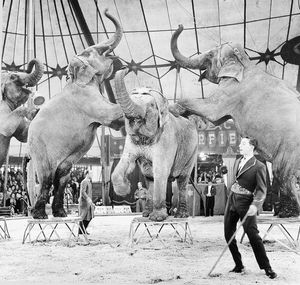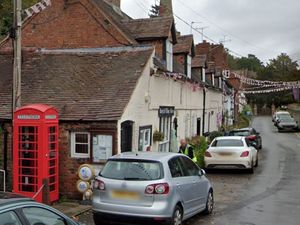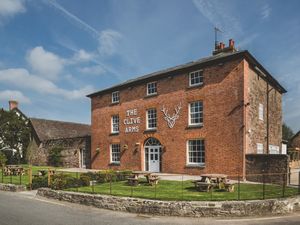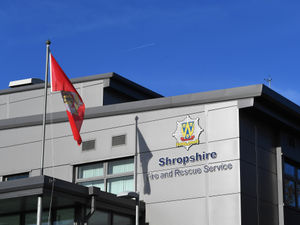End of the road for animal circuses?
The ringmaster cheerily steps aside, as four lions take their places on the stools. The youngsters gasp in astonishment as one of the lions opens its jaws, and the lion tamer thrusts his arm into the beat's mouth.

For generations of youngsters, watching performing circus animals was as much part of childhood as hopscotch and ice cream. Chipperfield's and Billy Smart's were names every youngsters was familiar with, and thousands would be drawn to see the big beasts every time the big top was in town.
Such scenes could very soon be a thing of the past. As the Great British circus celebrates its 250th anniversary, moves are thought to be afoot to outlaw the use of animals in circuses.
Michael Gove, the Environment Secretary, is expected to propose a new law banning the use of animals in circuses in England this year, after previous attempts by the Government were thwarted by lack of parliamentary time. A bill originally proposed by David Cameron during his time as prime minister was due to have received its second reading last year, but was abandoned due to the General Election.
Mark Pritchard, MP for The Wrekin, has been campaigning for an end to animals in circuses for several years.
"I do believe the Government will bring forward a ban soon," he says.
"The practice is cruel, antiquated an no longer necessary, given access to wild animals via modern media, and more people travelling abroad."
A spokesman for the Department for Environment, Food and Rural Affairs confirms that the Government hopes to ban the use of animal in circuses soon: "The Government wants to see an end to the use of wild animals in travelling circuses and will legislate for a ban as soon as parliamentary time allows."
The British circus celebrates its 250th anniversary this month. In January 1768, trick horse-rider Philip Astley was credited with creating a new form of entertainment when he marked out a ring and performed a series of stunts. Unlike most equestrian masters of the time, he performed he rode around in a circle – possibly giving rise to the name "circus" – and developed the act by filling the gaps in the programme by introducing acts such as acrobats and clowns. But the tradition of performing jungle animals is believed to have arrived in 1833, when American animal trainer Isaac A Van Amburgh walked into a cage containing several big cats.
Today, Peter Jolly's Circus in Craven Arms is one of only two circuses in England which are still licensed to use animals.
In 2016 the circus was at the centre of controversy after campaign group Animal Defenders International (ADI) showed video footage of a circus worker tormenting a camel and spitting in its eye.
The group also filmed fighting between animals, ponies tangled in short tethers, and claimed that on one occasion an animal was tethered for more than 40 hours. It said that during one 16-hour observation, zebras Watusi and Zumba, Kashmir the camel and Onkuli the ankole never left their barn.
The circus defended its record, saying: “We have held our licence to travel with performing wild animals for four consecutive years and during this time we have had three inspections by Defra, two announced and one unannounced.
“We also have to have four inspections per year by independent vets making a total of seven inspections per year. These inspections are carried out while on tour and at our winter quarters.
“All our inspection reports are available online at the Defra website for anyone to read."
The circus has in recent years included big cats trained by Thomas Chipperfield, from Cannock, who claims to be Britain's last lion tamer.
A member of the famous Chipperfield circus dynasty, he says the existing licensing system is extremely strict, and that there is little scientific evidence that animals suffer as a result of being kept in circuses.
Mr Chipperfield also dismisses claims that the tricks performed by circus animals are not natural.
"This is a fiction of the animal rights movement," he says.
"Tricks typically performed by circus tigers and lions, to give but two examples, include rolling over, sitting up, jumping and variations of the above.
"All of which are completely natural actions.
"The argument over whether or not it's environment is 'artificial' is irrelevant. It is arguable that any captive animal lives in an artificial environment."
He adds: "Almost all, if not every circus that features animals, either wild or domestic, advocates and encourages good animal welfare."
Mr Chipperfield also argues that circus animals play an educational role, if not in the show, in the "zoo" session at the end where people can look at the livestock.
"Here experienced keepers and the trainers are free to talk and answer questions from the visitors," he says.
"A number of circuses, including some which I have worked for, have staged educational presentations for school and university students and I myself have been approached to give lectures at universities and to offer assistance with a number of students' assignments."
But Mr Pritchard, who has in the past called for people to boycott Peter Jolly's Circus, says it is simply a case of exploiting wild animals for profit.
“Wild animals should be left in their natural habitats," he says.
"There are plenty of successful circuses who do not force animals to perform."
Mr Pritchard calls on the Government to end the "barbaric" practice, and for the animals to be rehoused in caring sanctuaries.
He appears to have public opinion on his side. A government consultation on the matter revealed that 94.5 per cent supported the ban.
Tim Phillips, of Animal Defenders International, says: "Circuses are no fun for animals.
"Confinement and deprivation are endemic to this industry whether the circuses are touring or not."





